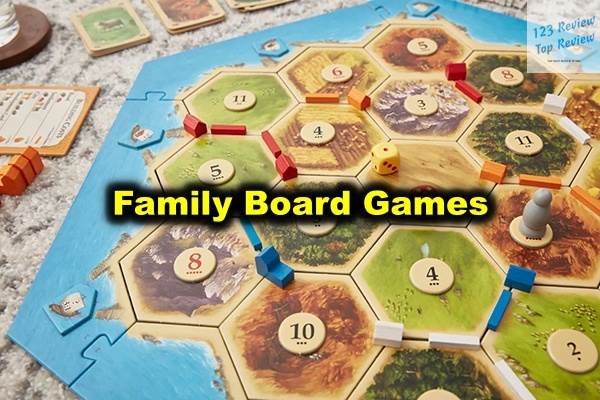Whether it’s a rainy day, a holiday gathering, or just a quiet evening at home, a well-chosen board game can turn any moment into a memorable one.
In this article, 123 Review’ll explore the many benefits of playing board games with family, dive into the different types of games available, highlight popular options, discuss age-appropriate choices, and offer tips for creating an unforgettable family game night.
Benefits of Playing Board Games with Family
Playing board games as a family is a tradition that transcends generations. But beyond the fun and laughter, board games offer a wealth of benefits that can positively impact every member of the family, from the youngest to the oldest.
Enhancing Communication Skills
One of the most significant advantages of playing board games is the improvement in communication skills. During gameplay, family members are required to articulate their thoughts, explain their strategies, negotiate deals, and express their opinions. This dynamic interaction fosters open communication and helps family members, especially children, develop better verbal and non-verbal communication skills. It’s also an opportunity for parents to model respectful conversation, active listening, and clear expression.

Moreover, games that require players to give clues, like Codenames, or to collaborate on decisions, like Pandemic, encourage thoughtful communication. These skills extend beyond the game, helping children navigate social situations, resolve conflicts, and express themselves more effectively in everyday life.
Fostering Teamwork and Collaboration
Many board games are designed around the concept of teamwork and collaboration. Cooperative games, where players work together to achieve a common goal, are particularly effective at teaching the value of teamwork. In games like Forbidden Island or Castle Panic, players must pool their resources, plan collectively, and make decisions as a group to succeed. This collaborative effort not only strengthens the bond between family members but also teaches valuable lessons in cooperation, compromise, and collective problem-solving.
For siblings, cooperative games can be especially beneficial, as they encourage a sense of unity and shared purpose. Instead of competing against each other, children learn to support one another and celebrate joint victories. This can reduce rivalry and foster a more harmonious family dynamic.
Encouraging Critical Thinking and Strategy
Board games are a fantastic way to sharpen critical thinking and strategic planning skills. Many games require players to think several steps ahead, analyze different possibilities, and make decisions based on available information. For example, games like Chess, Settlers of Catan, and Risk challenge players to develop and adapt strategies to achieve their objectives. These games help players learn to weigh the pros and cons of their choices, anticipate the consequences of their actions, and adjust their plans in response to changing circumstances.
For children, these experiences are invaluable. They help develop cognitive skills such as logical reasoning, pattern recognition, and decision-making. Over time, these skills become second nature, benefiting children academically and in real-life situations.
Types of Family Board Games
The world of board games is vast and varied, with options to suit every interest, age group, and playing style. Understanding the different types of family board games can help you choose the ones that best fit your family’s preferences.
Cooperative Board Games
Cooperative board games are a wonderful choice for families who enjoy working together toward a common goal. In these games, all players are on the same team, striving to overcome a challenge or complete a mission before time runs out or an obstacle is too great. Games like Pandemic, where players work together to stop global outbreaks, or Forbidden Desert, where teamwork is needed to escape a dangerous sandstorm, require collaboration, communication, and collective problem-solving.
Cooperative games are particularly effective at reducing the competitive tension that can sometimes arise during game nights. Instead of focusing on beating one another, players unite against the game itself, fostering a sense of camaraderie and shared achievement.
Competitive Board Games
For families that thrive on a bit of friendly rivalry, competitive board games are the way to go. These games pit players against each other, with each person striving to achieve a specific goal before the others do. Competitive games can range from simple, quick-play options like Uno or Connect Four to more complex and strategic games like Monopoly, Risk, or Ticket to Ride.
The competitive nature of these games can be exciting and energizing, offering plenty of opportunities for laughter, banter, and good-natured teasing. They also help players develop resilience, as losing a game gracefully is an important life skill. For families with a mix of ages, choosing games with varying levels of challenge can ensure that everyone feels engaged and has a fair shot at winning.
Educational Board Games
Educational board games combine entertainment with learning, making them an excellent choice for families with school-aged children. These games are designed to teach specific skills or knowledge areas while still being fun to play. For example, Scrabble enhances vocabulary and spelling, while The Game of Life introduces concepts like budgeting, career planning, and life choices. Games like Catan or 7 Wonders teach resource management and strategic planning, subtly reinforcing academic concepts such as math, history, and economics.
Educational games are a great way to reinforce what children are learning in school without making it feel like a chore. They also provide a platform for parents to engage with their children’s education in a relaxed and enjoyable setting.
Popular Family Board Games
When it comes to choosing a board game, the sheer number of options can be overwhelming. To help narrow it down, here’s a look at some of the most popular family board games, from timeless classics to modern hits.
Traditional Classics
Traditional board games are the backbone of family game nights and have been enjoyed by generations. These games are beloved for their simplicity, strategic depth, and ability to engage players of all ages. Chess and Checkers, for example, offer endless strategic possibilities with just a few basic rules, making them games that can be enjoyed again and again. Monopoly, another classic, is known for its blend of strategy, negotiation, and a bit of luck, keeping players engaged for hours.
These classics have stood the test of time because they offer a perfect balance of challenge and accessibility. They are also widely available, with countless variations and editions that can cater to different interests, whether you’re a fan of Star Wars, Disney, or your local sports team.
Modern Favorites
The board game industry has experienced a renaissance in recent years, leading to the creation of many innovative and engaging games that have quickly become modern favorites. Games like Ticket to Ride, where players build train routes across a map, or Carcassonne, a tile-placement game where players create a medieval landscape, offer fresh mechanics and immersive experiences. These games often appeal to both newcomers and seasoned gamers alike, providing a fun challenge without being overly complex.
Modern games like Catan have also introduced new concepts such as resource management, trading, and negotiation, offering a deeper level of strategy that can keep players coming back for more. These games are perfect for families looking to try something new and exciting, with themes and mechanics that differ significantly from traditional games.
Themed Board Games
Themed board games are a fantastic option for families who have specific interests or fandoms. These games immerse players in unique settings and storylines, making them more engaging and entertaining. For example, Harry Potter: Hogwarts Battle lets fans of the series work together as their favorite characters to defeat dark forces, while Disney Villainous allows players to step into the shoes of classic Disney villains and compete to achieve their nefarious goals.
Themed games often feature rich artwork, detailed components, and story-driven gameplay that make them feel like an extension of the worlds they are based on. They are a great way to bring a favorite movie, book, or TV show to life in a new and interactive way, making them particularly appealing for themed family game nights.
Age-Appropriate Board Games
Choosing the right board game for your family means considering the age and developmental stage of each player. Here’s a guide to selecting age-appropriate games that everyone will enjoy.
Best Games for Young Children
Young children benefit from games that are simple, colorful, and easy to understand. Games like Candy Land and Chutes and Ladders are perfect for this age group because they rely on basic counting, color recognition, and turn-taking. These games are designed to be quick to learn and play, ensuring that younger players don’t lose interest or get frustrated.
Another great option is Memory, which helps develop concentration and matching skills. The key with young children is to choose games that are engaging without being overly complex, allowing them to participate fully and experience the joy of playing.
Best Games for Tweens
As children grow older, they are ready for games that offer a bit more complexity and challenge. Tweens often enjoy games that require strategic thinking, creative problem-solving, and teamwork. Ticket to Ride is a great choice, as it introduces the concept of planning and executing long-term strategies. Dixit, a game of storytelling and imagination, is another hit with this age group, as it encourages creativity and abstract thinking.
For tweens, it’s important to choose games that strike a balance between being challenging and fun. Games that involve some degree of competition, strategy, or creativity tend to be popular with this age group, as they offer a sense of accomplishment and encourage social interaction.
Best Games for Teenagers
Teenagers often seek games that are intellectually stimulating, socially engaging, and offer a bit of a challenge. Strategy games like Catan, which involve resource management and negotiation, or Betrayal at House on the Hill, a horror-themed game with a dynamic storyline, are perfect for teens. These games require players to think critically, make strategic decisions, and interact with others, making them ideal for engaging teens who enjoy a more immersive and competitive experience.
Teenagers also appreciate games that allow for more complex gameplay and deeper strategies, so choosing games that offer these elements will keep them entertained and coming back for more. Additionally, games that involve social interaction, like party games or those with a storytelling component, are often a hit with this age group.
Tips for Choosing the Right Board Game
With so many board games available, selecting the right one for your family can be challenging. Here are some key factors to consider to ensure you choose a game that everyone will enjoy.
Evaluating Player Count
One of the first things to consider when choosing a board game is the number of players it supports. Some games are designed for two players, while others are best with a larger group. If you have a big family or often host game nights with friends, look for games that can accommodate more players. Conversely, if you’re looking for a game that’s just for you and your partner or one child, consider options that are specifically designed for two players, such as Patchwork or Jaipur.
It’s also worth noting that some games have expansions or variants that allow for more players, making them a versatile choice for different group sizes.
Considering Game Complexity
Another important factor is the complexity of the game. Games range from very simple, requiring only a few minutes to learn, to highly complex, with detailed rules and deep strategies. When choosing a game, consider the ages and experience levels of the players. Younger children or those new to board games might prefer simpler games like Uno or Spot It!, while experienced players might enjoy the strategic depth of games like Catan or Terraforming Mars.
Matching the game’s complexity to the players’ abilities ensures that everyone can participate and enjoy the game without feeling overwhelmed or bored.
Checking Playtime Length
The length of the game session is another crucial consideration. Some games can be played in under 30 minutes, making them ideal for a quick diversion, while others can take several hours to complete. If your family prefers shorter games, look for options with quick rounds or the ability to adjust the game’s duration. On the other hand, if you enjoy more in-depth gaming experiences, games with longer playtimes, like Risk or Twilight Struggle, might be more appealing.
It’s also helpful to have a mix of both short and long games in your collection, so you can choose the right one depending on how much time you have available.
Creating a Family Board Game Night
Hosting a family board game night is a fantastic way to bring everyone together for quality time. With a little planning, you can create an event that’s fun, relaxing, and memorable.
Setting Up the Space
The first step in creating a successful game night is setting up a comfortable and inviting space. Choose a room with good lighting and enough space for everyone to sit comfortably around the table. Make sure the table or playing surface is large enough to accommodate the game board, pieces, and any necessary accessories, such as scorecards or snacks.
Having a dedicated space for game night can help set the mood and make the experience more enjoyable. Consider adding some cozy touches, like soft lighting or background music, to create a warm and inviting atmosphere.
Selecting the Right Games
Variety is key to a successful game night. Choose a mix of games that cater to different interests, skill levels, and attention spans. Start with a light, quick-play game to warm up, then move on to more involved games as the night progresses. If you have a large group, consider games that accommodate multiple players or can be played in teams.
It’s also a good idea to involve everyone in the game selection process. Let family members take turns choosing the game, or pick a few options and vote on which one to play. This ensures that everyone feels included and excited about the night’s activities.
Planning Snacks and Refreshments
No game night is complete without snacks! Choose easy-to-eat finger foods that won’t create a mess on the game board. Popcorn, pretzels, fruit, and bite-sized treats are all great options. You can also theme your snacks to match the game, such as serving medieval-style treats for a game of Carcassonne or space-themed snacks for Terraforming Mars.
Don’t forget to have drinks on hand as well, whether it’s soda, juice, or hot chocolate. Keeping everyone refreshed and energized ensures that the fun can continue without interruptions.
Where to Buy Family Board Games
Once you’ve decided on the types of games that suit your family, the next step is finding the right place to buy them. Fortunately, there are plenty of options available, both online and in physical stores.
Online Retailers
Online shopping offers the widest selection of board games, often at competitive prices. Major retailers like Amazon, Walmart, and Target carry an extensive range of games, from classics to the latest releases. Shopping online allows you to read reviews, compare prices, and find special deals or bundles that might not be available in stores. Additionally, many online retailers offer fast shipping, so you can get your game in time for your next game night.
For those looking for more specialized or hard-to-find games, websites like BoardGameGeek or Miniature Market are excellent resources. These sites often feature detailed game descriptions, user reviews, and even recommendations based on your interests.
Local Game Stores
Supporting local game stores is not only good for your community but also a great way to discover new games. Many local game stores have knowledgeable staff who can provide personalized recommendations based on your family’s preferences and experience level. These stores often host events, such as game nights or tournaments, where you can try out new games before buying them.
Local game stores also tend to carry a selection of indie games and lesser-known titles that you might not find at big-box retailers. Shopping locally can lead to unique finds and help you build connections with other board game enthusiasts in your area.
Second-Hand Options
If you’re looking for a more budget-friendly option, consider buying second-hand board games. Thrift stores, garage sales, and online marketplaces like eBay or Facebook Marketplace are all great places to find used games at a fraction of the cost. Many second-hand games are in excellent condition, with all pieces intact, making them a great value.
When buying second-hand, it’s a good idea to check that all the components are present and in good condition. Some games also have replacement parts available from the manufacturer if needed. Second-hand shopping is an eco-friendly choice that can help you build a diverse game collection without breaking the bank.
Conclusion: Making Family Memories Through Games
Family board games are more than just a way to pass the time—they are a way to create lasting memories, strengthen family bonds, and foster important skills in a fun and engaging way. Whether you’re playing a time-honored classic, discovering a modern favorite, or diving into a themed adventure, the time spent around the game table is invaluable. With so many benefits, types of games, and options available, there’s something for every family to enjoy.
So gather your loved ones, choose a game, and let the fun begin. Through laughter, competition, and teamwork, you’ll create moments that everyone will cherish for years to come.





